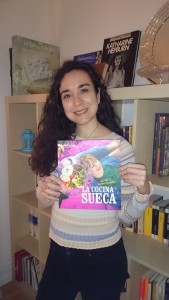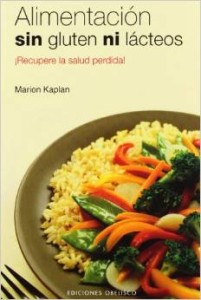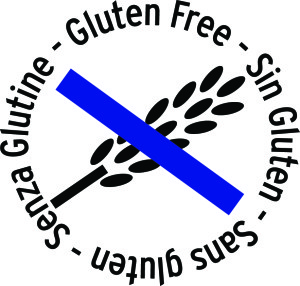
Fiberrik GF brödrecept
Min mormor skrattade alltid åt mig, att jag aldrig kunde följa ett recept exakt som jag hittat den. Mycket sant, jag läste det här receptet för ”paleo bröd” och gjorde lite ändringar. Resultatet är mycket smakrikt, mjukt och fluffigt, fiberrikt, proteinrikt, glutenfritt, och spannmålsfritt.
3,5 dl Arrowroot Powder
2,5 dl krossade linfrön
4 hela ägg
4 äggvitor
4 msk olivolja
1 tsk salt
4 tsk bakpulver (dubbelkolla att den inte har vete!)
1 tsk honung eller sirap (optionellt)
1 tsk Psyllium Husk pulver
Kokosolja (eller en annan olja) för brödformen
Värm ugnen till 175º C.
Blanda alla torra ingredienser. Blanda ihop de fuktiga ingredienserna (bara äggulorna från äggen dock) och blanda ihop det med det torra. Vispa upp de 8 äggvitorna till hårt skum och blanda in dem sist, försiktigt.
Smörj brödformen.
Baka i ugnen 30-35 minuter eller tills en tandpetare kommer ut rent när man provsticker.
Jag hittade arrowroot i den asiatiska mathandeln. Olivolja kan ersättas av valnötsolja. De hårdvispade äggvitorna gör att brödet blir extra fluffigt. Psyllium Husk hjälper brödet få en glutenliknande konsistens, blir fluffigt och smular inte. Njut!
Tacksam för att vara kvinna
(Bild: jag som 17-åring provade en härlig klänning i vild siden i vår kompis Janins butik i Palma)
Jag hade nyligen chansen att delta i några workshoppar om kvinnlighet.
Det känns oschysst, men de kvinnliga workshopparna fokuserade på hur underbara vi kvinnor är, hur var och en av oss är en gudinna med ändlös potential, hur vi är kärleksfulla och vänliga och hur vi borde ära och respektera vår kvinnliga essens. Å andra sidan, i den manliga workshopparna, men brukar få en hårdare behandling, med påminnelser om hur de borde bete sig och vad de borde göra. Kanske en anledning till detta är att kvinnor kan vara ganska perfektionistiska och känna sig deppiga över att inte åstadkomma tillräckligt mycket, och också känna att de inte får tillräckligt med kärlek och uppmärksamhet. Det var underbart att dela med sig lite kärleksfull beröring, kramar och vänskap med andra kvinnor.
Varför är män och kvinnor så annorlunda? Och varför är detta så bra? Naturen ämnade att vi skulle vara olika – de väsentligaste fysiologiska skillnaderna gör det möjligt att vi fortplantar oss. Men andra skillnader i kapacitet och karaktär gör oss komplementära. Livet blir rikare om det finns polaritet! Och denna polaritet är också nyckeln till att ett förhållande funkar, med den nästan magiska magnetismen i attraktionen mellan man och kvinna.
Det är faktiskt väldigt sorgligt att den moderna samhället motverkar polaritet så starkt. Kvinnor uppmuntras att bete sig mera manligt, klä sig mera som män, visa mindre av sina känslor. När vi glömmer bort allt vi har att dela med oss som kvinnor, potentialen av att skina på världen med vår närvaro blir helt enkelt mindre. Vi måste lära oss att respektera vår essens!
Ja, jag är kvinna. Jag har ändlös potential, samma som mina systrar. Jag är känslig och ibland emotionell. Jag är fantastiskt stark som person, men inte alltid när det kommer till muskelstyrka. Och jag älskar att en man kan ställa upp att lyfta en tung börda, eller att ha små ”ridderliga” gester, eller att erbjuda värdefull feedback och insikter från ”andra sidan”. Jag uppskattar män och deras värde. Jag är tacksam att jag är kvinna och känner mig ärad att kunna interagera med andra kvinnor (blivande gudinnor) samt att interagera med andra män (blivande gudar) och att känna mig berikad av deras input och skillnader.
Känn dig aldrig illa för att vara den du är! Du är unik.
Två artiklar som publicerades på engelska
Back in my college years, when I was studying Linguistics, I wrote an article about being multilingual and keeping those other languages alive. The online version that appeared some years later was edited, but the key ideas are still there. Read it here: ”Keeping Your Second Languages Alive.”
For their January newsletter, a large translation company asked me to write an article on balance in life, geared to translators. You can read it here: ”Effective Juggling for Translators”.
(PS: You will see that the published author’s name was Leticia, my official name – although I prefer Tisha, which is what I am using here in the blog).
”Det svenska köket”
Ibland sammanfaller mitt jobb som frilansöversättare med min passion för mat, matlagning och kultur. Under hösten 2014 fick jag uppdraget att översätta ”The Swedish Kitchen”, en utsökt liten bok om svensk kultur med några härliga gourmetrecepter, från engelska/svenska till spanska. Uppdraget kom från Svenska Institutet, en myndighet som främjar svensk kultur.
Häromdagen fick jag mina kopior av boken. Härligt! Du kan hitta den i svenska ambassader och konsulater runtom i världen, i flera språk (anm: jag översatte bara den spanska versionen).
Gluten basics
(Läs detta på engelska än så länge, är du snäll)
In May 2012 I was chatting on Facebook with a guy from Italy who had CF and he was telling me how well his health had turned out when doing a hypotoxic diet, and he prompted me to purchase the book by Marion Kaplan about a diet without gluten or dairy products (original French title: ”Alimentation sans gluten ni laitages”, cannot find an English version), insisting he believed I had a gluten intolerance. That was my first contact with the fascinating and astonishing world of gluten and its terrible effects on health.
Fortunately I found the Spanish version of the book that same day in a local bookstore and found in the first chapter a small test to self-evaluate regarding gluten. It stated if you answered “yes” to more than 12 of the symptoms, it was highly likely you had a gluten intolerance and should get tested. I replied positively to 18 of them!
Unfortunately, as I later found out, hospital tests (blood analysis, gut biopsy) only detect celiac disease, which is when the gut villi are completely gone. It is estimated that 1% of the population are celiac, although many are not diagnosed. What is not generally known is that around 40-60% of the population has a gluten intolerance that is beneath the level of celiac disease, in which the gut villi has only a partial atrophy.
Symptoms might be less severe, but since they are not necessarily related to digestion, neither patients nor doctors suspect of gluten.
And the problem is that currently in Europe we do not have hospital tests to detect this degree of intolerance. As far as I know, only Cyrex Labs have developed blood tests to measure it, but they are only available in the United States and Ireland.
What symptoms are we talking about? The most obvious ones are belly bloating and transit issues (constipation/diarrhea). But other symptoms cover tiredness and sleep problems, joint and bone pains, and systemic inflammation (which aggravates other problems such as asthma, breathing problems, fibromialgya, etc.). Regarding emotions, we find depression, behavioral problems (including ADD, ADHD, autism and bipolarity), and diverse hormonal issues (including thyroid and menstruation-related), even being excessively emotional. Then we also find skin problems, anemia (iron deficiency), osteoporosis, feeling cold, liver problems, autoimmune diseases…
A study was performed on children with epilepsy who did not respond to medication. When removing gluten from their diet, 50% of the children became asymptomatic.
Unfortunately this information is only getting known now, even though it’s been around for years. Doctor Tom O’Bryan is one of those who are more devoted to spreading the knowledge about the dangers of gluten. There are tons of clinical studies, but general practitioners don’t have it incorporated into their practices yet.
Why does gluten cause such diverse symptoms? Simple because when tearing the intestinal wall, it allows the gut toxins to get out to the blood stream and attack that part of our body which is more sensitive/delicate/prone to disease.
And why are there so many people with gluten problems now? One cause might be the gene modifications done to the wheat plant since the 1960s, due to which it has much more gluten than before (makes bread be more fluffy and desirable), and thus becomes more irritating for the guts. Besides, other factors that surround us (such as stress, chemical products in food, poor nutrition at large) makes us more likely to end up getting affected by the accumulated effect of daily exposure to gluten.
To conclude my story: I decided to make the test of spending two weeks without eating gluten. Then I ate one tablespoon of soy sauce (which had wheat in it) in a sushi lunch, and ten minutes later my belly had swollen 9 cm and I felt sickly all afternoon. Proof enough for me. Since then I have avoided wheat and foods containing gluten, and my digestion improved and my troubles got minimized. Later I discovered I also have a certain intolerance to other cereals, and I have been studying more and discovering there is gluten or wheat extract in the most unsuspected places. It is a whole patch of listening to your body and discovering a new world, unknown and unsuspected before that. I have learned and put into practice ways to heal the gut.
I wish I had had a coach to help me; I would have dealt with the issues much sooner. That is why it now feels important to me to be able to help others along this way. Having studied nutrition already, I went on to study coaching and doing courses to specialize in gluten and other intolerances. I feel confident that I can now offer help to many people, so they can have more health.
 Shamay Holistic Solutions
Shamay Holistic Solutions



